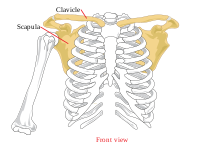
Photo from wikipedia
BACKGROUND Lower trapezius (LT) transfers were originally described to restore external rotation (ER) in the management of brachial plexus palsy; however, there is recent interest in the role of this… Click to show full abstract
BACKGROUND Lower trapezius (LT) transfers were originally described to restore external rotation (ER) in the management of brachial plexus palsy; however, there is recent interest in the role of this transfer to restore shoulder function, specifically ER, in patients with a massive irreparable rotator cuff tear (RCT). The purpose of this systematic review is to summarize the current literature pertaining to LT transfers, including biomechanics, techniques, and clinical outcomes for patients with brachial plexus palsy and massive RCTs. METHODS MEDLINE, EMBASE, and PubMed were searched for biomechanical and clinical studies, as well as technique articles. Four biomechanical studies reported on moment arms, range of motion (ROM), and force vectors. Seven clinical studies reported postoperative ROM and functional outcomes, and weighted mean improvements in ROM were calculated. RESULTS Overall, 18 studies were included, and then subdivided into 3 themes: biomechanical, technique, and clinical. Biomechanical studies comparing LT and latissimus dorsi (LD) transfers observed an overall larger moment arm in abduction and ER in adduction for the LT transfer, with similar results in forward elevation. Clinical studies noted significant improvement in shoulder function following the LT transfer, including ROM and functional outcome scores. There were several described techniques for performing the LT transfer, including arthroscopically assisted and open approaches, and the use of both allograft and autograft augmentation. CONCLUSION This study suggests that the LT transfer is generally safe, and the clinical and biomechanical data to date support the use of the LT transfer for restoration of function in these challenging patient populations.
Journal Title: Journal of shoulder and elbow surgery
Year Published: 2020
Link to full text (if available)
Share on Social Media: Sign Up to like & get
recommendations!